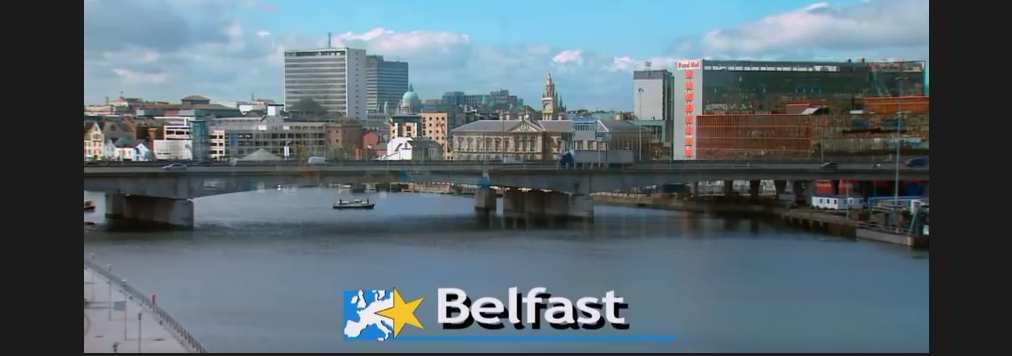Video Tour Belfast and Northern Ireland with Rick Steves

I recently posted a tour of the Republic of Ireland and referenced this post of Northern Ireland. So I thought it would be better to post about Northern Ireland while the other tour is fresh in the minds of those who have seen it. And for those who haven’t see it, here is the link to Video Tour the Irish Republic with Rick Steves.
Now let’s get started.
Ever want to take a trip to Ireland? Here is an easy way to view a bit of Northern Ireland and see if that motivates you to take the trip in person.
The video tour consists of 5 short YouTube videos. YouTube playlist videos will play continuously with only a few seconds transition from one video to the next . The 6th video is a 26 minute combination of the first 5 videos with just a few additional comments included.
Several more videos are on the 19 video playlist covering the Republic of Ireland and Western Ireland but I’ll be doing a separate post on them in the future.
Referenced in some of the videos is the historical conflict between Northern Ireland and the Republic of Ireland and also the conflict within Northern Ireland sometimes called “The Troubles”.
The following Wikipedia article provides some insights on this part of the “tour”.
The Troubles
| The Troubles | ||||||||
|---|---|---|---|---|---|---|---|---|
 Political map of Ireland |
||||||||
|
||||||||
| Belligerents | ||||||||
| State security forces |
Irish republican paramilitaries
|
Ulster loyalist paramilitaries | ||||||
| Casualties and losses | ||||||||
| British Army: 705[6] RUC: 301[6] NIPS: 24[6] TA: 7[6] Other UK police: 6[6] Royal Air Force: 4[6] Royal Navy: 2[6] (total: 1,049) |
||||||||
Irish Army: 1
Gardaí: 9
IPS: 1[6]
(total: 11)PIRA: 291[6]
INLA: 39[6]
OIRA: 27[6]
IPLO: 9[6]
RIRA: 2[6]
(total: 368)UDA: 91[6]
UVF: 62[6]
RHC: 4[6]
LVF: 3[6]
UR: 2[7]
(total: 162)
Total dead: 3,530[8]
Total injured: 47,500+[9]
All casualties: 50,000+[10]
|
|
||
The Troubles (Irish: Na Trioblóidí) is the common name for the ethno-nationalist[11][12][13][14] conflict in Northern Ireland that spilled over at various times into parts of the Republic of Ireland, England and mainland Europe. The conflict began in the late 1960s and is deemed by many to have ended with the Belfast “Good Friday” Agreement of 1998,[3][15][16][17][18] although there has been sporadic violence since then.[3][17][19] Internationally, it is also commonly called the Northern Ireland conflict[20][21][22][23][24] and has been described as a war.[25][26][27]
The conflict is primarily political but with strong ethnic and sectarian dimensions,[28] although it was not a religious conflict.[11][29] A key issue was the constitutional status of Northern Ireland. Unionists/loyalists, who are mostly Protestants and consider themselves British, generally want Northern Ireland to remain within the United Kingdom. Irish nationalists/republicans, who are mostly Roman Catholics and view themselves as Irish, generally want it to leave the United Kingdom and join a united Ireland. Another key issue was the relationship between these two communities. The conflict began amid a campaign to end discrimination against the Catholic/nationalist minority by the Protestant/unionist-dominated government and police force.[30][31] Another grievance was the introduction of internment (imprisonment without trial) for nationalists and the use of illegal interrogation methods originally acknowledged as torture.[32][33][34][35]
The main participants in the Troubles were republican paramilitaries (such as the Provisional IRA), loyalist paramilitaries (such as the UVF and UDA), the British state security forces (the British Army and the RUC, Northern Ireland’s police force), and political activists and politicians. The Republic of Ireland’s security forces played a smaller role. More than 3,500 people were killed in the conflict.
The Good News About Northern Ireland – It is Beautiful and Full of Charm.
Lets turn now to the expertly narrated and professionally filmed tour with Rick Steves.
The YouTube playlist will automatically transition from one short video to the next video and you can see an index of the videos to the right of the main window so you know where you are and where you are going next.
My Personal Interest
My mother’s side of the family emigrated from Belfast to Staten Island, New York in the late 19th century.
My grandfather was advised by his father to go to America to escape the frequent and bloody violence of that era.
When he arrived at Ellis Island he was about 19 or 20 years old. He was intelligent, though without much education, and willing to work hard.
He eventually met his bride, whose family came to America for similar reasons, living on Staten Island. She was born in America, however.
The family prospered first in the production of Irish linen goods and later in the coal and heating oil business.
My grandfather always maintained a strong tie to his Irish roots and he took his American family back to (Northern) Ireland for visits several times.
When I got to know him he was in his eighties, still spoke with an Irish brogue (accent) and loved to hear old Irish musical favorites.
I haven’t been to Ireland, yet, but I may someday make the trip and be able to give an eye-witness account.
Etc.
Please use the Share Buttons and/or email the post link below directly to your friends. Everybody likes to see and learn about Ireland.
Video Tour Belfast and Northern Ireland with Rick Steves
Thanks.
I appreciate it.

